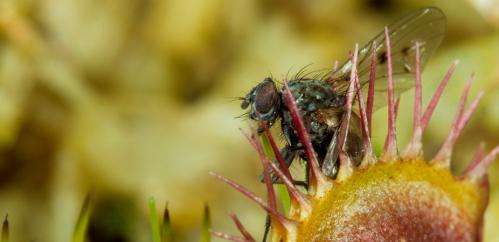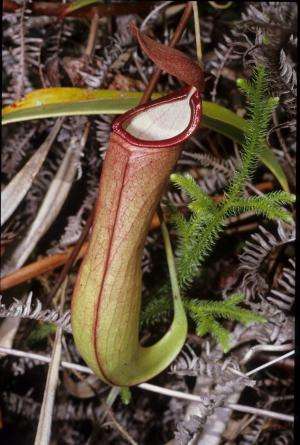Death traps: How carnivorous plants catch their prey

A new species of meat-eating plant was identified in Japan last month – but it is only one of more than 600 species of carnivorous plant around the world.
From busy Japanese prefectures to the lush jungles of south-east Asia, the billabongs of northern Australia to the rain-drenched mountains of South America, previously unknown species of carnivorous plants are being found, and many more await discovery.
Common to all carnivorous plants is a lack of nutriment in the environments in which they live. Through time, these plants have evolved the ability to trap prey and extract the nutrients they need to sustain growth and reproductive function and as a result, five different trapping mechanisms have evolved:
1.the pitfall
2.the sticky "flypaper"
3.the bladder trap
4.the corkscrew trap
5.the snap trap
The pitfall
The simplest trapping mechanism in carnivorous plants is the pitfall; a simple bucket-like receptacle, actually a highly modified leaf, containing digestive fluid into which prey falls or slips.
Nutriment is then extracted from the capture for the benefit of the plant.
Astonishingly, plants with pitfall traps have evolved on four continents from unrelated ancestors in a process called convergent evolution:
- the Cobra Lily (Darlingtonia) and trumpet pitchers (Sarracenia) of North America
- the sun pitchers (Heliamphora) and at least two bromeliads (Brocchinia reducta and Catopsis bertroniana) of northern South America
- the tropical pitcher plants (Nepenthes) largely from southeast Asia and Melanesia
- the Albany Pitcher Plant (Cephalotus) from southwest Western Australia
Sticky flypaper
Carnivorous plants that have evolved sticky substances on the leaf blades and other parts represent the most common method of trapping prey in terms of species numbers.
The best-known of these plants are the sundews (Drosera) and are found growing in a wide variety of conditions on all continents with the exception of Antarctica.

Lured by colourful foliage and glistening droplets of sticky fluid resembling water or honeydew atop a short glandular stalk, insects alight on the leaves only to find themselves permanently stuck.
In most species, the individual, sticky stalks can bend towards the prey, effectively suffocating it. The leaf blade can often fold and curl around the prey, shown in the video below, aiding the subsequent extraction and absorption of nutrients by special glands located on the leaf itself.
Other plants that use the flypaper method of trapping prey include the Rainbow Plants (Byblis) from Australia and New Guinea and the Butterworts (Pinguicula) from the Americas, Europe and northern Asia.
Bladder traps
Second in number to the flypaper traps are those carnivorous plants which possess bladder traps; the Bladderworts (Utricularia).
These plants can be aquatic, terrestrial or epiphytic (surviving on nutrients and water collected from air) but all have small bladder-like organs along the root system designed to catch and digest tiny invertebrates that thrive in the moist habitats occupied by these plants. These "bladders" have minute appendages – essentially triggers – next to a closed flap.
On the inside, the bladders are evacuated to a much lower pressure than that of the surrounds. When prey touches the trigger organs, the flap is quickly opened and the prey literally sucked inside. Watch the video below, but don't blink or you'll miss it.
Corkscrew traps
Genlisea, a relative of the bladderworts, has evolved yet another trapping mechanism, the corkscrew trap. These corkscrew plants grow in very wet environments such as dripping, mossy wefts, seasonally inundated wetlands and swamps.
Remarkably, Genlisea species possess no rootstock; they consist of a small, tight rosette of leaves that sit above ground and perform the normal function of photosynthesis. These plants also have a number of highly modified non-photosynthetic, underground leaves that not only serve as an anchor for the plant but also the traps for small invertebrate prey.
These fossorial leaves-turned-traps are distally bifurcated (an upside-down Y-shape). Both ends of the "Y" are twisted like a corkscrew creating a tunnel leading back up the inside of the trap.
The slit-like entrance to the hollow tunnel is lined with bristle-like structures pointing inwards and upwards allowing for prey to proceed in one direction only – further into the trap.
Once prey exits the corkscrew section of the trap, it enters a slightly swollen digestive chamber where nutrients are extracted from the prey.
Snap traps
It was with the 1768 publication of the scientific description of a most remarkable plant, the Venus Flytrap (Dionaea muscipula), that introduced to the world the fifth trapping mechanism utilised by carnivorous plants – the snap trap or bear trap.
Ever since, botanists and plant enthusiasts, laymen and the curious, have been fascinated by this most dramatic example of a plant that traps its own nutriment.
The leaf blade has evolved to resemble a steel leg trap (snap trap) with a fold in the middle, trapping teeth around the edges and trigger hairs and digestive glands on the lamina (leaf blade).
Touch a trigger hair once; nothing happens. Touch them twice and a fast-acting electrochemical process is set in motion causing changes in the leaf cells enabling the trap to close rapidly.
Over the next few hours, the trap closes more firmly on the prey, exudes digestive fluid and absorbs nutriment only to reopen a couple of days later and the trap is reset.
The Venus Flytrap has a close relative that employs an identical trapping mechanism; the Waterwheel Plant (Aldrovanda) an aquatic species thought to have evolved from Dionaea. It occurs sporadically across Africa, Europe, Asia and Australasia. Being smaller and aquatic, it is far less conspicuous than its North American cousin but nonetheless as deadly.
Carnivorous plants help animals too
It would appear carnivorous plants are inexorably deadly to all life that can fit within their traps but this is not necessarily the case.
A number of arthropod species have co-evolved with carnivorous plants, developing the means to thwart the plant and gain some benefit for themselves. Cyrtopeltis bugs in Australia, for example, can walk unaffected among the sticky secretions of sundews where it feeds on the prey the plant has trapped.
Various species of mosquito larvae survive and develop in the permanent pools of water in the traps of tropical pitcher plants and numerous spider species, with web to prevent them falling victim to the plant, lie in wait on trumpet pitcher traps catching prey before the plant does.
Such ecological systems lack research and require more study in order to improve our understanding of these fascinating relationships.
Source: The Conversation
This story is published courtesy of The Conversation (under Creative Commons-Attribution/No derivatives).
















